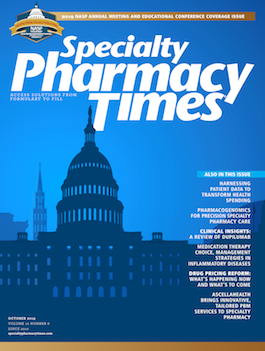PBM Co-pay Accumulator Programs Examined at NASP Annual Meeting
Reform of pharmacy benefit management (PBM) practices has been an issue under much scrutiny due to a belief these entities play a significant role in exacerbating high drug costs.
Reform of pharmacy benefit management (PBM) practices has been an issue under much scrutiny due to a belief these entities play a significant role in exacerbating high drug costs. During a session at the 2019 National Association of Specialty Pharmacy Annual Meeting and Expo, panelists Charles E. Collins, Jr, MS, MBA, president, Healthcare Stakeholder Solutions, LLC, and Krista Zodet, MSW, president of the HealthWell Foundation, discussed co-pay accumulator programs and their impact on drug accessibility for patients on specialty drugs.
“We talk about health insurance premiums and deductibles, and yes they go up, but we’re looking at why this change matters, where it does hit people who can’t afford this,” Collins said.
Patients’ premiums are increasing at a faster rate than wages can account for, and co-pay accumulator programs are a large part of the problem of rising premiums, according to Collins. “One-third of a patient’s income is sitting in health care. Something has to be done about this,” he said.
Historically, if a patient obtained a co-pay card for a drug, they would pay the co-pay amount, which would count toward their maximum out-of-pocket (MOOP) costs. However, now there is a trend of preventing drug manufacturer co-pay card financial assistance from counting toward a self-funded commercial patient’s MOOP expenses.
In 2019, Collins said the MOOP costs for an individual are $7900 and for a family, $15,800.
“If you think about the number in 2017, I showed a family at $14,700,” he said. “In 1 year, the new MOOP cap has gone up $1100. A family now has to make up that $1100 before they are capped out and insurance picks up on everything else. This discrepancy is silently happening, and patients can’t afford this, and they are wondering why.”
Collins said that co-pay accumulator programs affect 17% of approximately 140 employers (≤5000 workers), citing a National Business Group on Health survey. “There are about 50 million lives that are affected by copay accumulators,” he said.
Co-pay accumulator programs were originally intended for qualified deductible plans, that required employees to pay their deductible without co-pay card assistance from the drug manufacturer. In reality, they track utilization of manufacturer-sponsored co-pay assistance to ensure that contribution no longer counts toward a patient’s deductible, according to the panel. PBM practices then shift costs toward patients and manufacturers, and they ultimately reduce the overall contribution from payer or plan sponsors to the total spend on high-cost branded prescription medications, Collins said. Finally, these programs enforce the patient’s full payment of the deductible without subsidization from the manufacturer’s program toward the cost of the drug.
Collins also mentioned co-pay maximizers, which evolved from co-pay accumulator programs, as another new type of benefit for commercially insured patients. As the name implies, these programs are designed to exhaust the limits of manufacturer co-pay assistance programs. The total of a manufacturer’s co-pay assistance program is divided by 12 months to become the new monthly co-pay. PBM practices ensure patients sign up to receive co-pay cards from manufacturers and then raise the patient’s required co-pay to tap the discount cards for the maximum amount set by a pharma manufacturer. This seeks to ensure that 100% of a drug’s co-pay offset program is used for 100% of patients on the drug, whether or not the cost is evenly dispersed throughout the year.
Patients often do not know how these programs may affect their spending, since they have different names such as out-of-pocket (OOP) protection programs, specialty co-pay card programs, coupon adjustment benefit plan protection programs, or specialty co-pay solutions. Ultimately, the panelists said that patients bear the brunt of the tug-of-war between patients and manufacturers. For example, oncology drugs have a 33% abandonment rate when the monthly OOP cost is $100 to $500 and a 50% abandonment rate for OOP costs greater than $2000, according to Collins.
“In co-pay accumulator programs, patients are the losers. The irony is that we are trying to help them with all of this,” he said.
Zodet explained how her organization provides financial assistance to eligible patients with insurance who are struggling to cover their out-of-pocket costs for medical treatments. To date, they have awarded more than $1.6 billion in grants to assist patients with the cost of their treatments. All charitable patient assistance programs (CPAPs) assist commercially insured and Medicare patients.
She also detailed how accumulator programs only apply to commercially insured patients. If there is no manufacturer co-pay support, patients can use the CPAPs.
Accumulator programs do not apply to every patient, however. They are often limited to those who do not qualify for Medicare. Unfortunately, there are many ways that accumulator programs can harm patients, leaving them very little options as far as payment, she said.
On April 25, 2019, the Department of Health and Human Services finalized a proposal to allow private insurance plans to exclude the value of certain direct manufacturer cost-sharing support (co-pay coupons) from a patient’s annual cost-sharing limit. The final rule explicitly authorizes the types of novel accumulator adjustment programs that prevent manufacturer cost-sharing support from counting toward patients’ annual cost-sharing limits and that have been implemented by insurers with increasing frequency in recent years. Collins and Zodet concluded by stating that real reform of drug pricing practices will begin by taking a hard look into programs such as these and demanding change through legislation. They ended their session on a hopeful note, explaining that bans of co-pay accumulator programs have been enacted in Virginia and West Virginia, with similar bills pending in Connecticut, Illinois, Indiana, Kentucky, and North Carolina.

